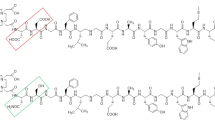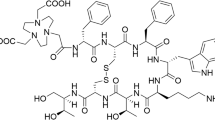Abstract
Neurotensin (NT) receptors are overexpressed in exocrine pancreatic cancer and Ewing's sarcoma. The potential utility of native NT in cancer diagnosis and therapy is, however, limited by its rapid degradation in vivo. Therefore, NT analogues were synthesised with modified lysine and arginine derivatives to enhance stability and coupled either to DTPA, to enable high specific activity labelling with indium-111 for imaging, or to DOTA, to enable high specific activity labelling with β-emitting radionuclides, such as lutetium-177 and yttrium-90. Based on serum stability (4 h incubation at 37°C in human serum) and receptor binding affinity, the five most promising analogues were selected and further evaluated in in vitro internalisation studies in human colorectal adenocarcinoma HT29 cells, which overexpress NT receptors. All five NT analogues bound with high affinity to NT receptors on human exocrine pancreatic tumour sections. The analogues could be labelled with 111In to a high specific activity. The 111In-labelled compounds were found to be very stable in serum. Incubation of HT29 cells with the 111In-labelled analogues at 37°C showed rapid receptor-mediated uptake and internalisation. The most promising analogue, peptide 2530 [DTPA-(Pip)Gly-Pro-(PipAm)Gly-Arg-Pro-Tyr-tBuGly-Leu-OH] was further tested in vivo in a biodistribution study using HT29 tumour-bearing nude mice. The results of this study showed low percentages of injected dose per gram tissue of this 111In-labelled 2530 analogue in receptor-negative organs like blood, spleen, pancreas, liver, muscle and femur. Good uptake was found in the receptor-positive HT29 tumour and high uptake was present in the kidneys. Co-injection of excess unlabelled NT significantly reduced tumour uptake, showing that tumour uptake is a receptor-mediated process. With their enhanced stability, maintained high receptor affinity and rapid receptor-mediated internalisation, the 111In-labelled DTPA- and DOTA-conjugated NT analogues are excellent candidates for imaging and therapy of exocrine pancreatic cancer, peptide 2530 being the most promising analogue.



Similar content being viewed by others
References
De Jong M, Breeman WA, Bernard BF, Bakker WH, Schaar M, van Gameren A, Bugaj JE, Erion J, Schmidt M, Srinivasan A, Krenning EP. [177Lu-DOTA(0),Tyr3] octreotate for somatostatin receptor-targeted radionuclide therapy. Int J Cancer 2001; 92:628–633.
De Jong M, Breeman WA, Bernard BF, Bakker WH, Visser TJ, Kooij PP, van Gameren A, Krenning EP. Tumor response after [(90)Y-DOTA(0),Tyr(3)]octreotide radionuclide therapy in a transplantable rat tumor model is dependent on tumor size. J Nucl Med 2001; 42:1841–1846.
De Jong M, Valkema R, Jamar F, Kvols LK, Kwekkeboom DJ, Breeman WA, Bakker WH, Smith C, Pauwels S, Krenning EP. Somatostatin receptor-targeted radionuclide therapy of tumors: preclinical and clinical findings. Semin Nucl Med 2002; 32:133–140.
Reubi JC, Waser B, Friess H, Buchler M, Laissue J. Neurotensin receptors: a new marker for human ductal pancreatic adenocarcinoma. Gut 1998; 42:546–550.
Ehlers RA, Kim S, Zhang Y, Ethridge RT, Murrilo C, Hellmich MR, Evans DB, Townsend CM Jr, Evers BM. Gut peptide receptor expression in human pancreatic cancers. Ann Surg 2000; 231:838–848.
Kuhar MJ. Imaging receptors for drugs in neural tissue. Neuropharmacology 1987; 26:911–916.
Vincent JP, Mazella J, Kitabgi P. Neurotensin and neurotensin receptors. Trends Pharmacol Sci 1999; 20:302–309.
Barroso S, Richard F, Nicolas-Etheve D, Reversat JL, Bernassau JM, Kitabgi P, Labbe-Jullie C. Identification of residues involved in neurotensin binding and modeling of the agonist binding site in neurotensin receptor 1. J Biol Chem 2000; 275:328–336.
Reubi JC, Waser B, Schmassmann A, Laissue JA. Receptor autoradiographic evaluation of cholecystokinin, neurotensin, somatostatin and vasoactive intestinal peptide receptors in gastro-intestinal adenocarcinoma samples: where are they really located? Int J Cancer 1999; 81:376–386.
Reubi JC, Zimmermann A, Jonas S, Waser B, Neuhaus P, Laderach U, Wiedenmann B. Regulatory peptide receptors in human hepatocellular carcinomas. Gut 1999; 45:766–774.
Reubi JC, Waser B, Schaer JC, Laissue JA. Neurotensin receptors in human neoplasms: high incidence in Ewing's sarcomas. Int J Cancer 1999; 82:213–218.
Wang L, Friess H, Zhu Z, Graber H, Zimmermann A, Korc M, Reubi JC, Buchler MW. Neurotensin receptor-1 mRNA analysis in normal pancreas and pancreatic disease. Clin Cancer Res 2000; 6:566–571.
Bergmann R, Scheunemann M, Heichert C, Mading P, Wittrisch H, Kretzschmar M, Rodig H, Tourwe D, Iterbeke K, Chavatte K, Zips D, Reubi JC, Johannsen B. Biodistribution and catabolism of18F-labeled neurotensin(8–13) analogs. Nucl Med Biol 2002; 29:61–72.
Egli A, Alberto R, Tannahill L, Schibli R, Abram U, Schaffland A, Waibel R, Tourwe D, Jeannin L, Iterbeke K, Schubiger PA. Organometallic99mTc-aquaion labels peptide to an unprecedented high specific activity. J Nucl Med 1999; 40:1913–1917.
Garcia-Garayoa E, Allemann-Tannahill L, Blauenstein P, Willmann M, Carrel-Remy N, Tourwe D, Iterbeke K, Conrath P, Schubiger PA. In vitro and in vivo evaluation of new radiolabeled neurotensin(8–13) analogues with high affinity for NT1 receptors. Nucl Med Biol 2001; 28:75–84.
Bruehlmeier M, Garayoa E.G, Blanc A, Holzer B, Gergely S, Tourwe D, Schubiger PA, Blauenstein P. Stabilization of neurotensin analogues: effect on peptide catabolism, biodistribution and tumor binding. Nucl Med Biol 2002; 29:321–327.
Garcia-Garayoa E, Blauenstein P, Bruehlmeier M, Blanc A, Iterbeke K, Conrath P, Tourwe D, Schubiger PA. Preclinical evaluation of a new, stabilized neurotensin(8–13) pseudopeptide radiolabeled with99mTc. J Nucl Med 2002; 43:374–383.
Schubiger PA, Allemann-Tannahill L, Egli A, Schibli R, Alberto R, Carrel-Remy N, Willmann M, Blauenstein P, Tourwe D. Catabolism of neurotensins. Implications for the design of radiolabeling strategies of peptides. Q J Nucl Med 1999; 43:155–158.
Srinivasan A, Schmidt MA. Tri-t-butyl DTPA: a versatile synthon for the incorporation of DTPA by solid phase. American Peptide Symposium 1997, p 110.
Reubi JC, Kvols LK, Waser B, Nagorney DM, Heitz PU, Charboneau JW, Reading CC, Moertel C. Detection of somatostatin receptors in surgical and percutaneous needle biopsy samples of carcinoids and islet cell carcinomas. Cancer Res 1990; 50:5969–5977.
Bakker WH, Albert R, Bruns C, et al. [111In-DTPA-d-Phe1]-octreotide, a potential radiopharmaceutical for imaging of somatostatin receptor-positive tumors: synthesis, radiolabeling and in vitro validation. Life Sci 1991; 49:1583–1591.
De Jong M, Breeman WA, Bakker WH, Kooij PP, Bernard BF, Hofland LJ, Visser TJ, Srinivasan A, Schmidt MA, Erion JL, Bugaj JE, Macke HR, Krenning EP. Comparison of (111)In-labeled somatostatin analogues for tumor scintigraphy and radionuclide therapy. Cancer Res 1998; 58:437–441.
Bakker WH, Krenning EP, Reubi JC, et al. In vivo application of [111In-DTPA-d-Phe1]-octreotide for detection of somatostatin receptor-positive tumors in rats. Life Sci 1991; 49:1593–1601.
Maoret JJ, Anini Y, Rouyer-Fessard C, Gully D, Laburthe M. Neurotensin and a non-peptide neurotensin receptor antagonist control human colon cancer cell growth in cell culture and in cells xenografted into nude mice. Int J Cancer 1999; 80:448–454.
De Jong M, Bernard BF, De Bruin E, Van Gameren A, Bakker WH, Visser TJ, Macke HR, Krenning EP. Internalization of radiolabelled [DTPA0]octreotide and [DOTA0,Tyr3]octreotide: peptides for somatostatin receptor-targeted scintigraphy and radionuclide therapy. Nucl Med Commun 1998; 19:283–288.
Author information
Authors and Affiliations
Corresponding author
Rights and permissions
About this article
Cite this article
de Visser, M., Janssen, P.J.J.M., Srinivasan, A. et al. Stabilised 111In-labelled DTPA- and DOTA-conjugated neurotensin analogues for imaging and therapy of exocrine pancreatic cancer. Eur J Nucl Med Mol Imaging 30, 1134–1139 (2003). https://doi.org/10.1007/s00259-003-1189-y
Received:
Accepted:
Published:
Issue Date:
DOI: https://doi.org/10.1007/s00259-003-1189-y




